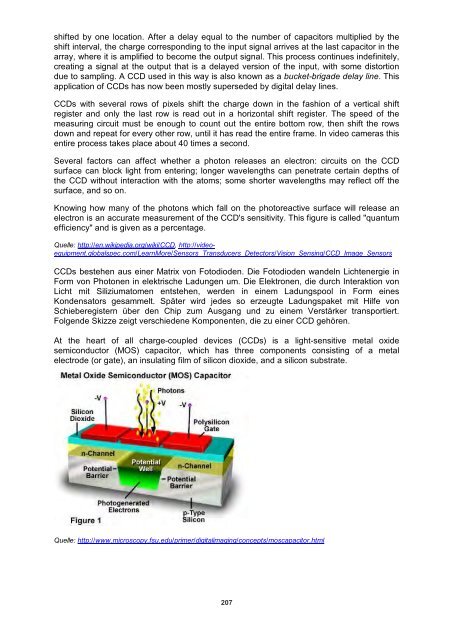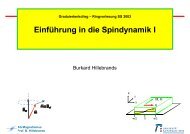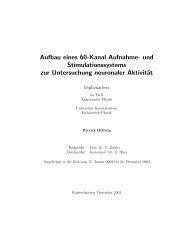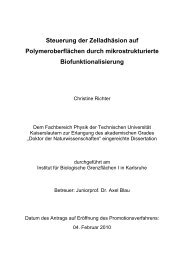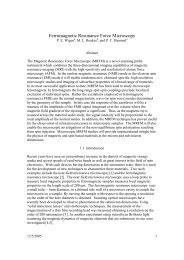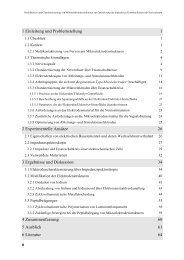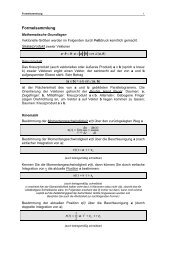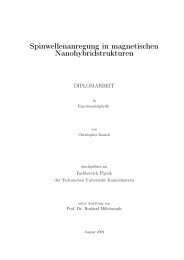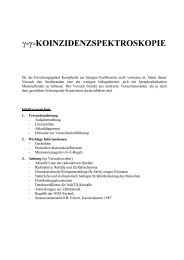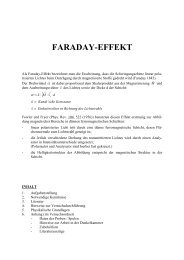Sensors and Actuators - Fachbereich Physik der Universität ...
Sensors and Actuators - Fachbereich Physik der Universität ...
Sensors and Actuators - Fachbereich Physik der Universität ...
Sie wollen auch ein ePaper? Erhöhen Sie die Reichweite Ihrer Titel.
YUMPU macht aus Druck-PDFs automatisch weboptimierte ePaper, die Google liebt.
shifted by one location. After a delay equal to the number of capacitors multiplied by the<br />
shift interval, the charge corresponding to the input signal arrives at the last capacitor in the<br />
array, where it is amplified to become the output signal. This process continues indefinitely,<br />
creating a signal at the output that is a delayed version of the input, with some distortion<br />
due to sampling. A CCD used in this way is also known as a bucket-brigade delay line. This<br />
application of CCDs has now been mostly superseded by digital delay lines.<br />
CCDs with several rows of pixels shift the charge down in the fashion of a vertical shift<br />
register <strong>and</strong> only the last row is read out in a horizontal shift register. The speed of the<br />
measuring circuit must be enough to count out the entire bottom row, then shift the rows<br />
down <strong>and</strong> repeat for every other row, until it has read the entire frame. In video cameras this<br />
entire process takes place about 40 times a second.<br />
Several factors can affect whether a photon releases an electron: circuits on the CCD<br />
surface can block light from entering; longer wavelengths can penetrate certain depths of<br />
the CCD without interaction with the atoms; some shorter wavelengths may reflect off the<br />
surface, <strong>and</strong> so on.<br />
Knowing how many of the photons which fall on the photoreactive surface will release an<br />
electron is an accurate measurement of the CCD's sensitivity. This figure is called "quantum<br />
efficiency" <strong>and</strong> is given as a percentage.<br />
Quelle: http://en.wikipedia.org/wiki/CCD, http://videoequipment.globalspec.com/LearnMore/<strong>Sensors</strong>_Transducers_Detectors/Vision_Sensing/CCD_Image_<strong>Sensors</strong><br />
CCDs bestehen aus einer Matrix von Fotodioden. Die Fotodioden w<strong>and</strong>eln Lichtenergie in<br />
Form von Photonen in elektrische Ladungen um. Die Elektronen, die durch Interaktion von<br />
Licht mit Siliziumatomen entstehen, werden in einem Ladungspool in Form eines<br />
Kondensators gesammelt. Später wird jedes so erzeugte Ladungspaket mit Hilfe von<br />
Schieberegistern über den Chip zum Ausgang und zu einem Verstärker transportiert.<br />
Folgende Skizze zeigt verschiedene Komponenten, die zu einer CCD gehören.<br />
At the heart of all charge-coupled devices (CCDs) is a light-sensitive metal oxide<br />
semiconductor (MOS) capacitor, which has three components consisting of a metal<br />
electrode (or gate), an insulating film of silicon dioxide, <strong>and</strong> a silicon substrate.<br />
Quelle: http://www.microscopy.fsu.edu/primer/digitalimaging/concepts/moscapacitor.html<br />
207


